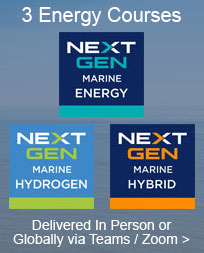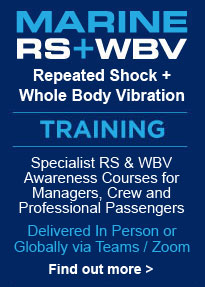MoD Boats Team Decarbonisation Briefing

15.06.2023

Phil Gittins - Boats Team Leader DE&S Ships
Phil Gittins, Boats Team: 'There's a challenge coming - decarbonisation. What do we do and how do we change the wide range of our Fleet?'
'We have been on a bit of a journey that started last year at Seawork, particularly on the ferry back from Speed@Seawork and a conversation with John Haynes who came in and did some training with us to raise our awareness across the team of the issues that we faced.'
Seawork 2023 - MoD Industry Briefing
Phil Gittins - Boats Team Leader - DE&S Ships
I think what struck me from that training was there were lots of issues, but there were also boats with a huge amount of opportunity as well. So we've got lots of craft to play with. We go through midlife upgrades, we buy new craft, we have old craft that are available for experimentation.
Compared to the rest of the DE&S Ships world who deal with the frigates and the warships we can be pretty quick. We're pretty cheap and also I've got a great team who are really engaged in decarbonization. So it's a really good opportunity. We've set ourselves out a vision to really challenge the rest of DE&S as to what we're doing and drive this forward
One of the things we looked at is the size of the problem - our Fleet is generating as much carbon as 14,000 cars. That gives you a scale for the amount of carbon we're generating and there are loads of technologies out there that we could be looking at.
We also have a really wide range of craft. Right from simple Cadet craft which are used by Sea Cadets all the way to the Royal Marines craft which are fast, deployed onto ships and have to do boarding operations or go up against peer adversaries.
That is a really big spectrum, what we've decided to do is start at the simple end. We'll learn some skills and then move towards those really complex craft. We'll build some awareness, we'll understand the technologies and move forward.
First Steps
So we took the Cadet boat and we started. We now have an electric Cadet boat with zero emissions and there's a real side benefit there that when you take the diesel out of something it becomes really quiet. If you've ever tried engaging teenagers and educating them I think you'd appreciate the benefit of a quiet boat where they can actually hear what you're saying - it's quite clear that it's them ignoring you rather than not hearing you.
This is a bit of detail about what we did there with a parallel path development. We did a study that looked at the use requirement case and the requirement in the use case. We did a design for the electric boat. We interviewed the users, we looked at safety, we looked at the what we call DLODs. Defence Lines Of Development - all of the infrastructure and training aspects of support. It was really driven by 'you go and ask the users what they want'. They want six knots for eight hours because that's what they feel they use and that's how they do the fuel tank.
eBoats & Charging
But if you're doing electric boats and think of that energy graph that was too big and basically by the time you put all the batteries on for that, the boat was at the bottom of the lake. So one of our suppliers, thank you to Barrus, offered to put something together and we built a prototype. That's what really moved us forward and helped us learn what are the benefits and what we can do there. It was a simple, fairly standard design. I'm sure that a lot of that is similar to cars and other electric systems. Although I'd love to talk about the engineering I don't think I'm anywhere near qualified.
The key thing here is about what did we learn from this exercise. We learned that the infrastructure is going to be a huge problem. We own our infrastructure so we can control it and we can change it. Many users don't, many operators don't. But even then we have to understand the cost of putting electrical hookups into where we need it. Many of these jetties where these odd boats operate are old, they are by a building that's in quite a remote location on a long chain, so getting that quality of electrical supplies is a real challenge.
Business & Use Cases
We need to understand the business case, as we have to make a business case to Navy. We have to put a financial case together that says we're going to save on diesel, we're going to save on that energy. We've got to predict what the cost of electricity would be in the electric boat case. We've also got to work out how Navy is valuing carbon and are they actually going to pay to reduce our carbon emissions.
But then finally we learned about the use case, the importance of the use case. The energy profile of the users that we need and how the boat is going to be used, because energy is becoming more expensive to put in the boat or more critical. As you put that energy system into the boat for the propulsion system, you need to refine it more. You really need to understand how the boat's going to be used. You can't be lazy and just say here is a big plastic fuel tank and we'll put in as much fuel as we need and if we get it wrong it doesn't matter. The new systems are going to have to be really tuned to that use case.
Going Forward
So what are we doing going forward? From those lessons we've identified three things that we can go forward with. First of all we're taking the Cadet boat and we're looking at a diesel-electric version to free us up from the infrastructure constraints. Then we're going to write a business case, and we've got funding to do this, that says for each location is it best to put an electric boat, a hybrid or just leave it as diesel. We'll put together a business case and we'll learn how to make the right arguments to get any kind of carbon reduction through.
The other thing we're doing is baselining our fleets. We did a quick and dirty exercise which came to the 14,000 cars. But we're now going to measure and there's a call out to all of our in-service support suppliers, our biz suppliers, to come back with proposals as to how we can measure our boats and get those profiles gathered. We'll be doing that this year and we've got some of that funding secured and we'll find a way of doing that.
Future Ships
We're also talking to Future Ships to make sure that as future ships within the Navy are being procured they are provisioning for different propulsion technologies. So thinking about the space, thinking about if they're going to end up using more batteries, how are they going to feed those through. Thinking about how they're going to accommodate different fuels. Because at the moment it's really easy, we use the same fuel as the ship and therefore we just tap off the ship and we use that fuel. We won't be able to do that in the future so we're engaging with them to make sure that is provisioned for.
So that's what we're doing and certainly we've got a vision to do more than that. There are a few things that that I wanted to suggest that we could be doing, not this financial year but next financial year. Maybe we'll be looking at having followed on from the Cadet boats, we'll be able to look at a diesel-electric boat going into an in-service craft. Maybe it'll be the Army dive support boats, maybe the combat support boats. Something like that, take the diesel-electric solution and put that into a more military application than the Cadet boat using our learning and our understanding.
Energy Data
What I'd really like to do, maybe next year we could publish our use cases. I would be really keen to find a way to take government data, remove any defence vulnerability from that data and publish it to industry so that you can go out there and design boats with propulsion systems that meet those kind of use cases, because I think it would help everyone in that development space. We need to find a way of doing that in the future.
Then maybe we can identify a single location where we have boats, where we have some boats that always operate out of the same harbour and look at an energy flow from wherever that energy comes from. Where it's generated all the way to the harbour, onto the craft to propel that craft. Try and look at how we contract for, how we create a whole energy chain. Because I think that's something that we can do and many other users can't. I think that's something that DE&S Boats should be moving in towards that space. So those are my thoughts, that's where I think we can go in the future that's what we're doing this year.
MoD Boats Team and Royal Navy attended:
NEXT GEN Marine ENERGY Training >
Phil Gittins, MoD Boats Team Leader, presented at:
NEXT GEN Energy ANALYSIS Workshop >
All images are copyright NEXT GEN Marine Ltd 2024 unless otherwise stated.
This does not exclude the owner's assertion of copyright over the material.











